The Traveler… a great loss…
October 20, 2014 by The Traveler · Leave a Comment
Today I traveled to Springfield, Massachusetts, by way of The Springfield Union dated October 21, 1964. There the front page had the headline of “World Mourns Death of Herbert Hoover”, “President Orders 30-Day Observance; Leaders of Both Parties Join in Eulogies”. “Herbert Clark Hoover, the son of a blacksmith who rose to serve his nation as president and the world as one of history’s great humanitarians, died Tuesday. He was 90…”. This includes a small photo of President Hoover as well as a photo of the flag being lowered to half staff over the White House. Inside the issue is a photo of the home where Hoover was born, where he would also be buried on a hillside nearby.
The Traveler… books for all… daring wears…
July 7, 2014 by The Traveler · Leave a Comment
 Today I traveled to Atlanta, Georgia, by way of The Atlanta Constitution dated July 7, 1914. There I found that Andrew Carnegie was being extremely generous… “Carnegie Willing To Endow Library In Every County”. He was going to be donating between $75,000.000 and $100,000,000 to establish libraries in country districts. “…He is determined to give his money away and die poor, and here is an opportunity. Seventy per cent of the people of the United States still are without access to good libraries…”.
Today I traveled to Atlanta, Georgia, by way of The Atlanta Constitution dated July 7, 1914. There I found that Andrew Carnegie was being extremely generous… “Carnegie Willing To Endow Library In Every County”. He was going to be donating between $75,000.000 and $100,000,000 to establish libraries in country districts. “…He is determined to give his money away and die poor, and here is an opportunity. Seventy per cent of the people of the United States still are without access to good libraries…”.
The front page also has a headline “Young Swimmer, Who Wore One-Piece Suit at Piedmont, Dares Dangerous Hell Gate”. This shows includes a photo of Miss Nora Leahy in a sleeveless, skin-tight garment… which the year prior men were not even permitted to wear suits with sleeves less than an inch in length. My how far we’ve come! Is modesty based purely on cultural norms and/or expectations, or are there certain absolutes – 3rd world regions aside?
~The Traveler
“Wrongway” Corrigan is honored with a backwards headline…
June 9, 2014 by TimHughes · Leave a Comment
The Los Angeles “Herald Express” newspaper of August 5, 1938 honored the interesting exploits of Douglas Corrigan with a rarity in the newspaper world: a headline printed backwards.
This was one of the fascinating tidbits of aviation history. Corrigan flew from Long Beach, California to New York & wanted to fly to Ireland but was denied. So he filed his flight plan to return to Long Beach but flew instead to Ireland, stating “navigational errors” due to heavy cloud cover, etc. (see hyperlink for details). He was given a ticker tape parade in New York City with the banner headline reporting: “N.Y. Millions In Bedlam of Noise and Tons of Confetti Greet L.A. Air Hero” with subheads and a large photo of the parade.But the fascinating part of this item is the banner headline at the very top of the ftpg: ” ! NAGIRROC YAW GNORW OT LIAH” and with a small note below it stating: “If You Don’t Know, Read this the Way Corrigan Flew–Backwards!“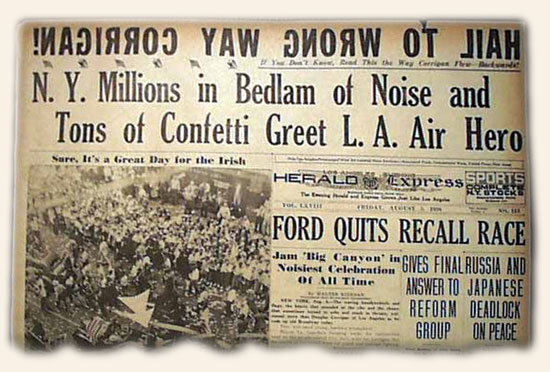
Seeking the best of the 20th century…
May 23, 2014 by TimHughes · Leave a Comment
 The introduction to collecting old newspapers for most typically comes through finding a newspaper of recent past with a headline remembered from history class. They turn up in flea markets, garage sales, and attics, but wherever the discovery, there is a fascination which—for many—begins a quest to find more and better.
The introduction to collecting old newspapers for most typically comes through finding a newspaper of recent past with a headline remembered from history class. They turn up in flea markets, garage sales, and attics, but wherever the discovery, there is a fascination which—for many—begins a quest to find more and better.
Of the five centuries from which old newspapers can be found, the 20th century has one distinct advantage and that is displayability. It was just before the turn of the 20th century that newspaper competition was rampant in the United States and bigger and bigger headlines became one method of grabbing attention over a competitor’s newspaper on the corner newsstand. Headlines from the Spanish-American War of 1898 were often large and dramatic, and that format carried well into the 20th century. Although the aim was to sell more newspapers, the unintended long-term consequence was to intrigue the collector with an enticing headline that would look great on display.
I will touch on some of the more notable events of the 20th century, in chronological order, which may present a “checklist” of events which would be great additions to any collection.
Their can be little question that the oil industry transformed the American landscape, and the first major discovery happened at the beginning 20th century with the Spindletop well near 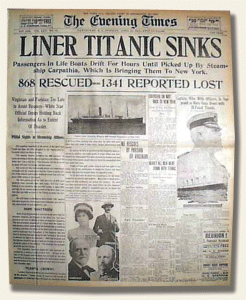 Houston. Just two years later the Wright brothers would make history with their first powered flight, again an event which would transform that way the entire world lives. The first major natural tragedy would be the San Francisco earthquake of 1906, and many newspapers provided graphic details.
Houston. Just two years later the Wright brothers would make history with their first powered flight, again an event which would transform that way the entire world lives. The first major natural tragedy would be the San Francisco earthquake of 1906, and many newspapers provided graphic details.
The sinking of the Titanic was the next major tragedy which dominated the headlines for not just a day but for several weeks, and newspapers did much to dramatize the event & its investigation. While some newspaper maintained a very conservative format, others sported full banner headlines in bold type with illustrations and photos to make for an appealing front page. Just 3 years later the sinking of the Lusitania would receive similar response by newspaper publishers across the country.
World War I made headlines in American newspapers beginning in 1915, but it was America’s entry in the war in 1917 that would spark more detailed coverage of the war that would end in 1918. News of the armistice ending the war would result in some of the largest & most dramatic headlines to appear in newspapers up to that time.
Following the war, baseball would enter its golden era when Babe Ruth came on the scene, he becoming one of the first of the major stars of the 20th century and capturing headlines in newspapers across the country. But just prior to his hay-day was the infamous “Black Sox” 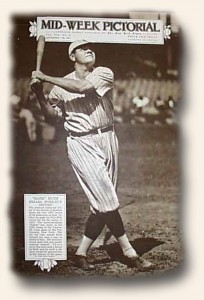 scandal of the Chicago White Sox, with charges of fixing the 1919 World Series games involving several Chicago players. But those headlines would soon be supplanted by the exploits of Ruth as his record-breaking streak added much excitement to the game of baseball and newspapers were only too happy to comply with considerable coverage. Other stars would find prominence as well, including fellow Yankees Lou Gehrig & Joe DiMaggio, and later on Ted Williams & Jackie Robinson among the more notable.
scandal of the Chicago White Sox, with charges of fixing the 1919 World Series games involving several Chicago players. But those headlines would soon be supplanted by the exploits of Ruth as his record-breaking streak added much excitement to the game of baseball and newspapers were only too happy to comply with considerable coverage. Other stars would find prominence as well, including fellow Yankees Lou Gehrig & Joe DiMaggio, and later on Ted Williams & Jackie Robinson among the more notable.
Charles Lindbergh’s accomplishment of being the first to fly solo across the Atlantic caused him to be one of the most famous men in the world at the time, and newspaper coverage was exceptional. But shortly after his 1927 flight the gangster era came to the attention of newspaper, the St. Valentine’s Day massacre of 1929 being one of the first major events to find front page coverage across the country. This fascinating era would extend into the mid-1930’s and names such as Al Capone, John Dillinger, “Baby Face” Nelson, “Legs” Diamond and “Dutch” Schultz were commonly found on front pages.
The stock market crash of 1929 would trigger the Great Depression, which affect the entire nation in so many ways. Collectors look for the most dramatic wording in such a headline, with “Crash” “Tragedy” and similar cataclysmic words making for desirable collector pieces.
Other sports and sports stars would come to prominence in newspapers of the day, including golfer Bobby Jones and his Triple Crown accomplishment in 1930; Phar Lap, one of the 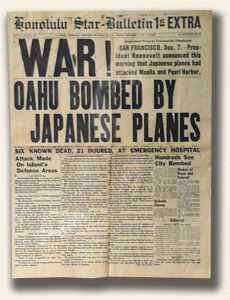 more famous race horses of the 20th century; Jim Thorpe and his Olympic and football prowess; Jesse Owens at the 1936 Olympics, World Cup soccer, Notre Dame football, boxing greats Jack Johnson, Jack Sharkey, Max Schmeling & Joe Louis commanding headlines, and so much more. There was such extensive coverage of sports in the 20th century that many build huge collections with this singular theme.
more famous race horses of the 20th century; Jim Thorpe and his Olympic and football prowess; Jesse Owens at the 1936 Olympics, World Cup soccer, Notre Dame football, boxing greats Jack Johnson, Jack Sharkey, Max Schmeling & Joe Louis commanding headlines, and so much more. There was such extensive coverage of sports in the 20th century that many build huge collections with this singular theme.
Perhaps the most defining event of the 20th century was World War II, begun with the ascendency of Adolf Hitler and the Nazi party in Germany and his invasion of Poland in 1939. With America’s entry in the war upon the attack on Pearl Harbor, barely a single newspaper for the next 4 ½ years would be devoid of war coverage. Because such issues were commonly saved and found in attics by their children, collectors pursue only the most major events and with the largest headlines. Tops of the list would be Pearl Harbor, battle of Midway, the D-Day invasion, the death of Hitler, the end of the war in Europe, the dropping of the atomic bomb, and the end of the war in the Pacific. Many tabloid-size newspapers had the entire front page consumed by headlines, lending themselves to displayability, particularly given their smaller size.
The Korean War would begin the 1950’s, and would be followed by events of the Cold War. At the end of the decade music would begin making some headlines, led by Elvis Presley and more tragically with the airplane death of Buddy Holly & Richie Valens. A few years later the Beatles would come on the scene to define the music world for the 1960’s.
 Politics always made headlines in the 20th century which began with McKinley and ended with Bill Clinton, but perhaps the most collectible political person would be John F. Kennedy. His assassination –the second of the 20th century–stunned the world , and some headlines were extremely dramatic. Always the “best of the best” would be newspapers from where the event happened, so it is no surprise that Dallas newspaper reports on the JFK assassination draw the most interest.
Politics always made headlines in the 20th century which began with McKinley and ended with Bill Clinton, but perhaps the most collectible political person would be John F. Kennedy. His assassination –the second of the 20th century–stunned the world , and some headlines were extremely dramatic. Always the “best of the best” would be newspapers from where the event happened, so it is no surprise that Dallas newspaper reports on the JFK assassination draw the most interest.
Although the space era began as early as 1928 with the work of Robert Goddard, it was the success of Sputnik & the resulting space race in the late 1950’s that would captivate the headlines. America made its mark in the early 1960’s with Alan Shepard and John Glenn, culminating in 1969 with the landing of men on the moon & their safe return.
Scattered throughout the 20th century are many memorable names which made the occasional headline, including Mark Twain, Thomas Edison, Houdini, Albert Einstein, Rudolph Valentino & Walt Disney to name but a few.
Regardless what events or themes a collector might pursue from the 20th century the challenge is to find the most dramatic and impactful report. Large headlines command a premium, and when photos or graphics accompany a headline it only adds to the appeal. Collectors know some great headline reports are lurking out there just begging to be found. The thrill is finding them, and make them prized additions to their collection.
Great Headlines Speak For Themselves… Salk’s Vaccine!
May 16, 2014 by GuyHeilenman · Leave a Comment
The best headlines need no commentary. Such is the case with the Journal American, April 12, 1955: “Salk’s Vaccine Works!”
The Traveler… Leo Frank… “Watchful, Waiting”…
April 7, 2014 by The Traveler · Leave a Comment
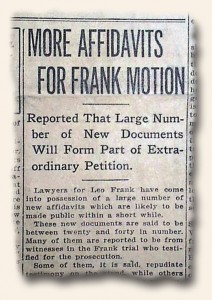 Today I traveled through Atlanta, Georgia by the way of The Atlanta Constitution dated April 7, 1914. There I found the defense attorneys for Leo Frank had come into possession of a large number of new affidavits which would be made public shortly. Also coverage of the war in Mexico between Carranza and Pancho Villa. This also has the reporting of the Fall of Torreon with the reporting of the expulsions of the Spaniards.
Today I traveled through Atlanta, Georgia by the way of The Atlanta Constitution dated April 7, 1914. There I found the defense attorneys for Leo Frank had come into possession of a large number of new affidavits which would be made public shortly. Also coverage of the war in Mexico between Carranza and Pancho Villa. This also has the reporting of the Fall of Torreon with the reporting of the expulsions of the Spaniards.
“Watchful, Waiting” policy is how Lloyd Brown was dealing with his 14-year marriage as he was bringing a divorce suit to court. He said shortly into the marriage his wife “began to take a violent dislike to him… She had not only left the house, but had taken all the covers off the bed before so doing. I borrowed some more from a neighbor and, when my wife came back in the morning,…I explained to her that to her that things couldn’t go along that way much longer… I just sat there and said nothing. Well, that made her madder and madder, I just sat still and kept quiet. Finally she hit me over the head with a fire shovel.” She left that night and never returned. Divorce granted.
~The Traveler
The Traveler… the verdict… the change… yeah, yeah, yeah…
March 17, 2014 by The Traveler · Leave a Comment
 Today I traveled back in time through The Detroit Free Press of March 15, 1964. The issue featured a banner headline “How Dallas Jury Reached Verdict of Death for Ruby” in which “…the four women and eight men jurors reached the decision — one of four possible verdicts open to them — after just two hours and 20 minutes of deliberation…”. Ruby was on trial for shooting to death Lee Harvey Oswald, who killed President John F. Kennedy. Ruby did appeal the case but died from a pulmonary embolism as the date for his new trial was being set.
Today I traveled back in time through The Detroit Free Press of March 15, 1964. The issue featured a banner headline “How Dallas Jury Reached Verdict of Death for Ruby” in which “…the four women and eight men jurors reached the decision — one of four possible verdicts open to them — after just two hours and 20 minutes of deliberation…”. Ruby was on trial for shooting to death Lee Harvey Oswald, who killed President John F. Kennedy. Ruby did appeal the case but died from a pulmonary embolism as the date for his new trial was being set.
Just a few weeks prior, Cassius Clay had defeated Sonny Liston in the world heavy weight boxing match. “‘Cassius X’ Says He’s a ‘Prophet'” said “…his Muslim name is ‘Muhammad Ali and I’m a true follower of Elijah Muhammad. I face east five times a day…”. This is when he started using Muhammad Ali as his known name.
And just for fun, “Happiness is a 40-ft. Beatle”… yeah, yeah, yeah!!!
-The Traveler
The Traveler… Oklahoma ship sinks… suing from beyond the grave…
January 6, 2014 by The Traveler · Leave a Comment
 Today I journeyed through Omaha, Nebraska, via The Omaha Daily Bee of January 6, 1914. The issue had the report of the oil tanker Steamer Oklahoma splitting in two and sinking south of Sandy Hook, New Jersey. Several of the crew had perished in this disaster while others were rescued by other ships.
Today I journeyed through Omaha, Nebraska, via The Omaha Daily Bee of January 6, 1914. The issue had the report of the oil tanker Steamer Oklahoma splitting in two and sinking south of Sandy Hook, New Jersey. Several of the crew had perished in this disaster while others were rescued by other ships.
Another article is one of the Supreme Court handing down a decision permitting Miss Florence Schenck, who had died just a few hours earlier, to prosecute a suit against Charles H. Wilson to vindicate her good name. Mr. Wilson had induced her years earlier to marry him in a ceremony in England. She later found that he already had a wife living in England as well and was suing for damages.
~The Traveler
#25 – Best of the 20th century? (*revisited)
January 3, 2014 by GuyHeilenman · Leave a Comment
As newspaper collectors we dream of “the event” we’d like to add to our collection. It’s the search for that issue–or issues–which make this a fascinating hobby. This is, after all, a very visual hobby. How displayable are stamps and coins? Huge headlines proclaiming a cataclysmic event or magnificent achievement lend themselves so well to display, much more so than an original document about the event.
The 20th century had a great wealth of interesting events. But what is the best? If you could only make one choice, what single headline of the 20th century would you most want to see in your collection?
I wrestle with how to approach this thought: most life-altering? most recognizable? most historic? most appealing for display? I believe the first Wright brothers’ flight is the most life-altering; “Dewey Defeats” Truman” as the most recognizable; and a great “Titanic Sinks” report as the most displayable. Some newspapers did much with the events of the gangster era, and certainly the “careers” of Bonnie & Clyde, John Dillinger and Al Capone are well known and significant reports would be attention-grabbers on any wall. On a more positive note there are some spectacular “V-E Day” and “V-J Day” issues celebrating the end of World War II. But limiting myself to just a single issue I would take “Titanic Sinks”. ….what’s your thought?
*The Fall of 2013 marked the 5th anniversary of the History’s Newsstand Blog by Timothy Hughes Rare & Early Newspapers. We are grateful to have the opportunity to contribute to the newspaper collecting community, and appreciate those who have participated through guest posts, comments, and readership. In 2014 we will revisit the top 25 posts (measured by activity), with the number 1 post being revisited during the first week of 2015. Please enjoy. If you would like to contribute a post for consideration of inclusion on the blog, please contact Guy Heilenman at guy@rarenewspapers.com.
The Traveler… let her in… hard to replace…
October 21, 2013 by The Traveler · 4 Comments
Today I traveled to Omaha, Nebraska, by the way of The Omaha Daily Bee dated October 21, 1913. There I found a very interesting British lady had been detained at Ellis Island for the past three days, that being militant suffragist leader Emmeline Pankhurst. She had come to the States to do lecture engagements. “…It was difficult to imagine that the slightly built, gray haired little woman who stepped ashore from the ferry boat at the 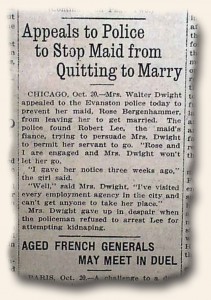 Battery was the same person that for several years had caused the British government so much trouble by reason of her militant tactics in behalf of woman suffrage or her incitation to militancy for the ’cause,'”. It took President Wilson and the Secretary Wilson of the Department of Labor issuing an order of release to allow her admittance into the country.
Battery was the same person that for several years had caused the British government so much trouble by reason of her militant tactics in behalf of woman suffrage or her incitation to militancy for the ’cause,'”. It took President Wilson and the Secretary Wilson of the Department of Labor issuing an order of release to allow her admittance into the country.
Did you ever think that you were irreplaceable on your job? A maid, Rose Bergenhammer, found this to be true. She was engaged to be wed and gave her employer, Mrs. Dwight, three weeks notice. Mrs. Dwight went to every employment agency and could not find anyone to take her place. When Rose tried to leave, Mrs. Dwight called the police and tried to have her fiance, Mr. Lee, arrested on attempted kidnapping charges. Rose must have been a fantastic maid!
~The Traveler




